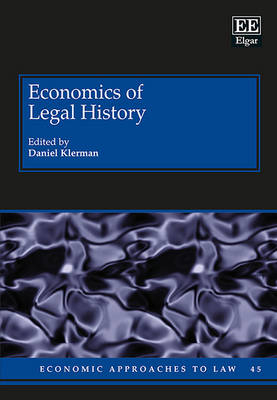
Economics of Legal History
Edward Elgar Publishing Ltd (Verlag)
978-1-78347-168-3 (ISBN)
Generations of law and economics scholars have been fascinated by history, seeing in its institutions and laws a vast database for illustrating their theories. Equally, historians have seen economic analysis as a helpful tool with which to analyse legal institutions. As a result a vibrant field has emerged in which people trained in law, economics, history and political science have all made significant contributions. This research review identifies the most important works examining legal history from an economic perspective.
Edited by Daniel Klerman, Charles L. and Ramona I. Hilliard Professor of Law and History, University of Southern California, US
Contents:
Acknowledgements
Introduction Daniel Klerman
PART ILAW AS DEPENDENT VARIABLE: EFFICIENCY AND BEYOND
1. Harold Demsetz (1967), ‘Toward a Theory of Property Rights’, American Economic Review, 57 (2), May, 347–59
2. Zeynep K. Hansen and Gary D. Libecap (2004), ‘The Allocation of Property Rights to Land: US Land Policy and Farm Failure in the Northern Great Plains’, Explorations in Economic History, 41 (2), April, 103–29
3. Paul G. Mahoney (2001), ‘The Political Economy of the Securities Act of 1933’, Journal of Legal Studies, XXX (1), January, 1–31
4. Daniel Klerman (2007), ‘Jurisdictional Competition and the Evolution of the Common Law’, University of Chicago Law Review, 74 (4), Fall, 1179–226
PART IILAW AS INDEPENDENT VARIABLE: WOMEN’S AND MINORITY RIGHTS
5. James J. Heckman and Brook S. Payner (1989), ‘Determining the Impact of Federal Antidiscrimination Policy on the Economic Status of Blacks: A Study of South Carolina’, American Economic Review, 79 (1), March, 138–77
6. John R. Lott, Jr. and Lawrence W. Kenny (1999), ‘Did Women’s Suffrage Change the Size and Scope of Government?’, Journal of Political Economy, 107 (6, part 1), December, 1163–98
7. Grant Miller (2008), ‘Women’s Suffrage, Political Responsiveness, and Child Survival in American History’, Quarterly Journal of Economics, 123 (3), August, 1287–327
PART IIILAW AS INDEPENDENT VARIABLE: THE GLORIOUS REVOLUTION
8. Douglass C. North and Barry R. Weingast (1989), ‘Constitutions and Commitment: The Evolution of Institutions Governing Public Choice in Seventeenth-Century England’, Journal of Economic History, XLIX (4), December, 803–32
9. Nathan Sussman and Yishay Yafeh (2006), ‘Institutional Reforms, Financial Development and Sovereign Debt: Britain 1690–1790’, Journal of Economic History, 66 (4), December, 906–35
10. Daniel M. Klerman and Paul G. Mahoney (2005), ‘The Value of Judicial Independence: Evidence from Eighteenth Century England’, American Law and Economics Review, 7 (1), Spring, 1–27
11. Dan Bogart (2011), ‘Did the Glorious Revolution Contribute to the Transport Revolution? Evidence from Investment in Roads and Rivers’, Economic History Review, 64 (4), November, 1073–112
PART IVBIDIRECTIONAL HISTORIES: THE RECIPROCAL INTERACTIONS OF LAW AND SOCIETY
12. Avner Greif and David D. Laitin (2004), ‘A Theory of Endogenous Institutional Change’, American Political Science Review, 98 (4), November, 633–52
13. Avner Greif (2006), ‘History Lessons: The Birth of Impersonal Exchange: The Community Responsibility System and Impartial Justice’, Journal of Economic Perspectives, 20 (2), Spring, 221–36
14. Claire Priest (2006), ‘Creating an American Property Law: Alienability and its Limits in American History’, Harvard Law Review, 120 (2), December, 385–458
PART VPRIVATE ORDERING
15. Robert. C. Ellickson (1989), ‘A Hypothesis of Wealth-Maximizing Norms: Evidence from the Whaling Industry’, Journal of Law, Economics, and Organization, 5 (1), Spring, 83–97
16. Karen Clay and Gavin Wright (2005), ‘Order Without Law? Property Rights During the California Gold Rush’, Explorations in Economic History, 42 (2), April, 155–83
17. Avner Greif (1989), ‘Reputations and Coalitions in Medieval Trade: Evidence on the Maghribi Traders’, Journal of Economic History, 49 (4), December, 857–82
PART VILITIGATION AND CONTRACTING
18. Claire Priest (2001), ‘Currency Policies and Legal Development in Colonial New England’, Yale Law Journal, 110 (8), June, 1303–405
19. Daniel Klerman (2012), ‘The Selection of 13th-Century Disputes for Litigation’, Journal of Empirical Legal Studies, 9 (2), June, 320–46
20. J. Mark Ramseyer (1995), ‘The Market for Children: Evidence from Early Modern Japan’, Journal of Law, Economics, and Organization, 11 (1), April, 127–49
PART VIICRITIQUE OF THE ECONOMIC APPROACH TO LEGAL HISTORY
21.Robert W. Gordon (1984), ‘Critical Legal Histories’, Stanford Law Review, 36 (1-2), January, 57–125
Index
| Erscheint lt. Verlag | 27.3.2015 |
|---|---|
| Reihe/Serie | Economic Approaches to Law series |
| Verlagsort | Cheltenham |
| Sprache | englisch |
| Maße | 169 x 244 mm |
| Themenwelt | Geschichte ► Teilgebiete der Geschichte ► Militärgeschichte |
| Recht / Steuern ► EU / Internationales Recht | |
| Recht / Steuern ► Rechtsgeschichte | |
| Wirtschaft ► Volkswirtschaftslehre | |
| ISBN-10 | 1-78347-168-9 / 1783471689 |
| ISBN-13 | 978-1-78347-168-3 / 9781783471683 |
| Zustand | Neuware |
| Haben Sie eine Frage zum Produkt? |
aus dem Bereich


